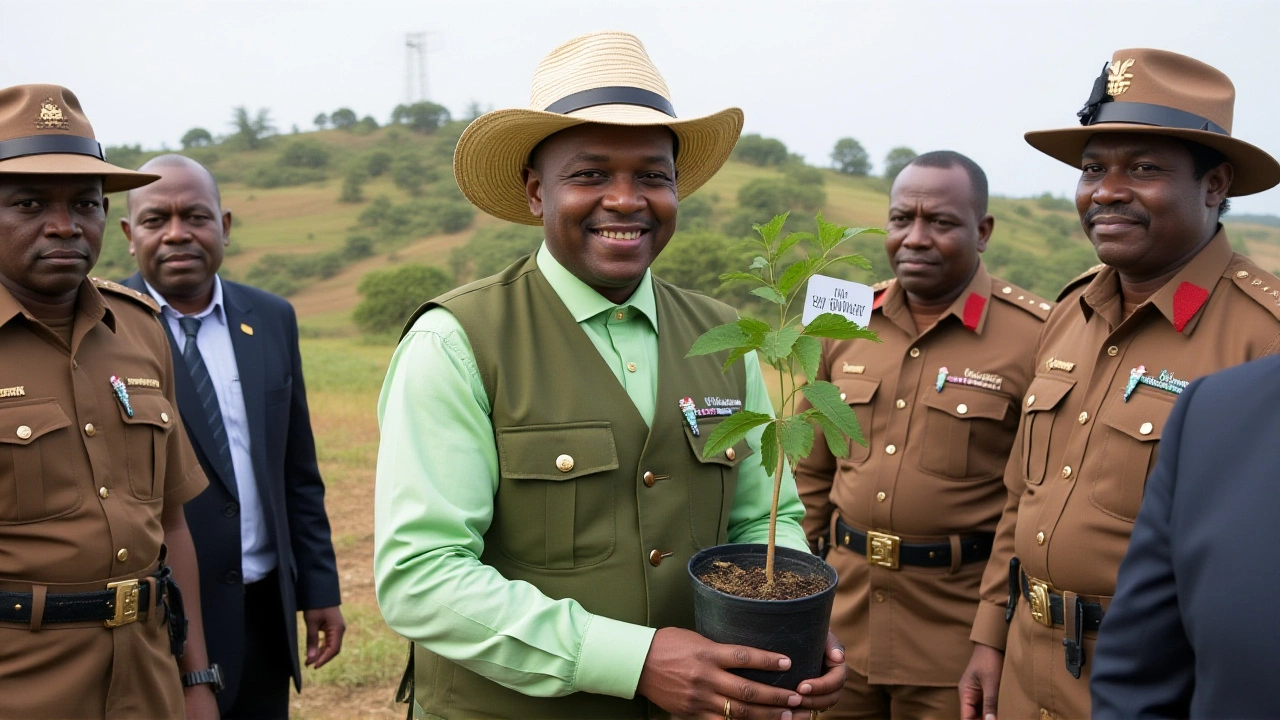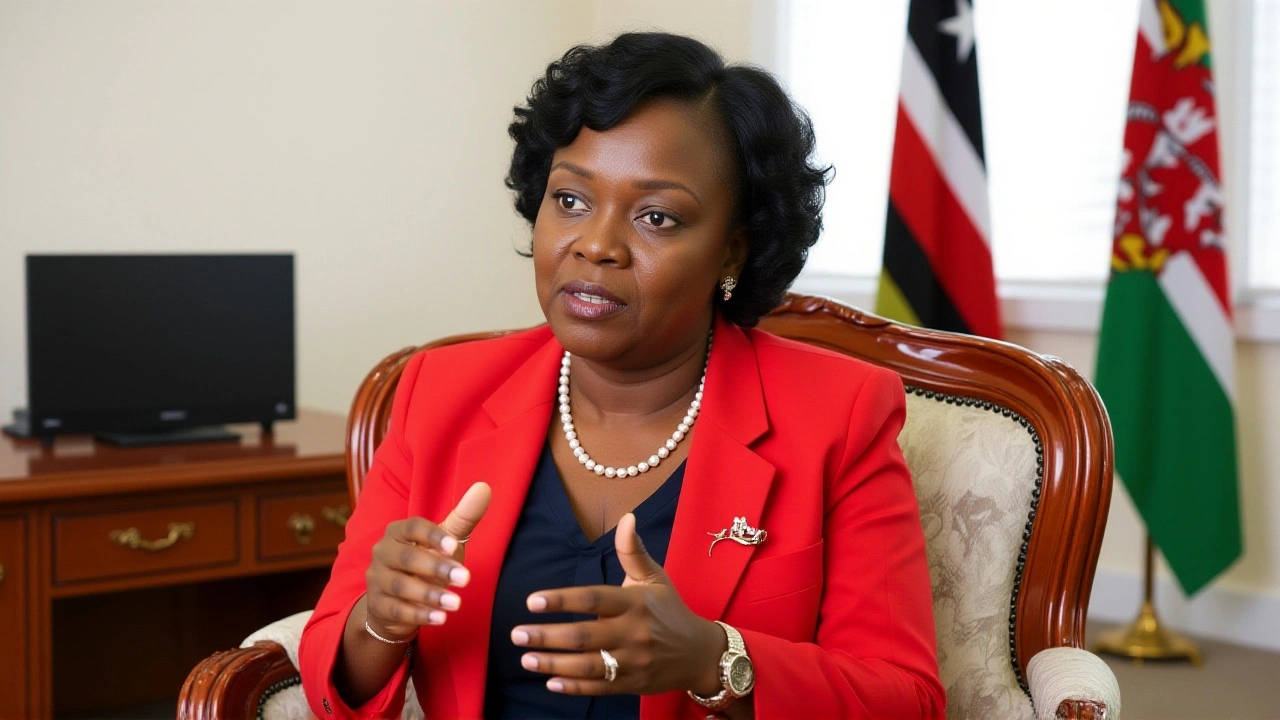On Friday, October 10, 2025, Kenya will turn its primary schools into green corridors as part of a sweeping fruit‑tree planting drive. The effort aims to sow exactly 100 million fruit trees across the country’s 57,000 public primary schools, a move announced by the nation’s top environmental officials just days earlier.
During a high‑profile ceremony at Kabu Primary School in Trans Nzoia County, the initiative was unveiled by Dr. Deborah Barazza, Cabinet Secretary for Environment of Ministry of Environment and George Tarus, Secretary for Forest Development of the same ministry.
Why Fruit Trees, Not Just Any Trees?
The shift from generic afforestation to fruit‑bearing species marks a strategic pivot. Mango, avocado, and citrus varieties were singled out because they promise three‑fold benefits: carbon sequestration, nutrition for children, and income streams for schools and surrounding families. In a video message released on October 8, 2025, Barazza emphasized that the trees could generate "over Sh3 billion in economic value within three years" while also cooling classrooms during Kenya’s hot seasons.
Scale of the Operation
Each school is tasked with planting a minimum of 2,000 saplings. Learners are encouraged to take extra seedlings home, extending the canopy into their own villages. Stephen Sugut, Director of Primary Education of Ministry of Education confirmed that distribution channels are already in motion: 12 regional nurseries under the Kenya Forest Service have dispatched seedlings to every school, and many institutions have already exceeded their targets ahead of the October 10 deadline.
- Target: 100 million fruit trees across 57,000 schools.
- Minimum per school: 2,000 saplings.
- Projected economic impact: Sh3.2 billion in annual fruit sales by 2028.
- Job creation: 85,000 green jobs for youth and women.
- Survival goal: 80 % tree survival rate monitored through the rainy seasons.
Historical Context and Past Achievements
Kenya’s tree‑planting ambition was launched on December 1, 2022, with a pledge to reach 15 billion trees by 2032. Since then, the government claims to have planted "over 1.06 billion trees," dwarfing the previous administration’s tally of 38 million. The current Mazingira Day push builds on that momentum, marking the first time fruit trees dominate the national agenda.
According to a report in The Star on October 8, 2025, Tarus highlighted that the country now operates 5,000 community forest associations and 200 tree nurseries, infrastructure that will support the massive seedling distribution.

Corporate and Community Backing
Private sector partners have already pledged support. Safaricom PLC donated 5 million seedlings, while Brookside Dairy Limited contributed Sh200 million to fund training and monitoring.
The "Rudi Pamoja" (let’s come together) social‑media campaign, launched on September 15, 2025, has mobilised roughly 12 million Kenyans, encouraging citizens to volunteer at their local primary schools on Mazingira Day.
What It Means for Kids and Communities
With 12.8 million primary‑school learners spread across Kenya’s 47 counties, the program is poised to touch virtually every child’s daily life. Nutrition experts note that fruit trees can directly address the 18 % malnutrition rate among children under five, as reported by UNICEF in 2024. Moreover, schools will integrate tree‑care modules into the Competency‑Based Curriculum for Grades 4‑8 starting January 2026, turning environmental stewardship into a formal subject.
Monitoring, Survival Rates, and Future Steps
County environment committees will conduct monthly inspections throughout the long rainy season (March‑May 2026) and the short rainy season (October‑December 2025). The goal is to achieve an 80 % survival rate, a figure supported by recent agronomic studies that show proper post‑planting care can boost longevity by 30 %.
Beyond the initial planting, the Ministry of Environment plans to launch agro‑forestry and bamboo development strategies, linking the fruit‑tree value chain to processing facilities and local markets. This holistic approach aims to create "green jobs"—from nursery staff to fruit‑packing operators—thereby tackling youth unemployment, which currently sits at 22 % nationwide.

Challenges Ahead
While optimism runs high, logistical hurdles remain. Transporting seedlings to remote schools in the northern Turkana region, for instance, demands coordination between the Kenya Forest Service and local NGOs. Additionally, climate variability poses a risk; drought‑prone areas will need supplemental irrigation to ensure seedlings take root.
Key Takeaways
Kenya’s Mazingira Day fruit‑tree drive is more than a planting exercise—it’s a multi‑layered development agenda that intertwines climate action, food security, education, and economic growth. If the targets are met, the country could be on track to hit its 30 % forest‑cover goal by 2032, while simultaneously delivering tangible benefits to millions of learners and their families.
Frequently Asked Questions
How will the fruit‑tree program affect school budgets?
Participating schools will receive seedlings at no cost, funded by the Kenya Forest Service and corporate donors. Over time, fruit sales are projected to generate up to Sh3.2 billion annually, which many schools plan to reinvest in infrastructure, teaching materials, and student scholarships.
Which regions are expected to face the biggest planting challenges?
Remote northern counties such as Turkana and Marsabit struggle with limited road access, making seedling delivery difficult. NGOs operating in those areas are partnering with the Ministry of Environment to use motorbike couriers and community volunteers to bridge the logistics gap.
What measures are in place to ensure tree survival?
County environment committees will perform monthly monitoring, checking soil moisture, pest damage, and growth rates. Schools receive training manuals and access to local agronomists who advise on watering schedules, especially during the dry spells between rainy seasons.
Will the program create new jobs for Kenyan youth?
Yes. The Kenya National Bureau of Statistics estimates 85,000 green jobs will arise in nurseries, fruit‑processing plants, and agro‑tourism ventures by 2028, targeting unemployed youth and women in rural communities.
How does the initiative align with Kenya’s 2032 forest‑cover goal?
By adding 100 million fruit trees, the program contributes roughly 1 % to the total canopy needed for the 30 % forest‑cover target. Combined with ongoing community forest projects, Kenya aims to stay on track for its 15 billion‑tree ambition by 2032.

13 Responses
Wow, this is a massive step forward for Kenyan schools – turning classrooms into living labs with fruit trees is a brilliant idea. It not only helps the environment but also gives kids fresh produce and a chance to learn about sustainability.
Reading about the 100 million fruit‑tree drive really made me think about how interwoven climate action and food security can become when we involve the youngest generation. Planting mango, avocado and citrus in every primary school creates a green canopy that will absorb carbon while shading students during the hottest parts of the day. Each sapling is a future source of nutrition, potentially cutting down on the 18 % malnutrition rate among children under five that UNICEF highlighted. The economic angle is just as exciting – Sh3.2 billion in fruit sales by 2028 could fund school infrastructure, textbooks, and even scholarships for the poorest families. By embedding tree‑care modules into the curriculum, teachers turn a simple planting activity into a lifelong lesson in stewardship and entrepreneurship. This kind of hands‑on education beats textbook theory every time, because kids see the growth, taste the fruit, and understand the value chain from seed to market. Moreover, the creation of 85,000 green jobs for youth and women aligns perfectly with Kenya’s push to lower its 22 % youth unemployment rate. Community forest associations and local nurseries will gain new business, strengthening rural economies beyond the school gates. The plan to monitor survival rates through monthly inspections shows a commitment to data‑driven outcomes, which is essential for scaling any environmental program. If the 80 % survival target is met, that means 80 million trees will actually thrive and start producing within a few years. The involvement of big donors like Safaricom and Brookside Dairy also signals that the private sector sees real value in this green transition. The “Rudi Pamoja” campaign has already mobilised 12 million volunteers, proving that public enthusiasm can match governmental ambition. From a policy perspective, this initiative dovetails nicely with Kenya’s 2032 forest‑cover goal, adding roughly 1 % of the required canopy. The integration of agro‑forestry and bamboo strategies in the next phase hints at even broader biodiversity benefits. Overall, the project feels like a win‑win: cleaner air, healthier kids, more jobs, and a stronger economy – all sprouting from a simple seed. I hope other nations take note and replicate this model, adapting it to their own contexts.
Yo peeps! This tree thing is super cool – imagine our kids chilling under mango shade while snacking on fresh fruit 🎉. I’m all in for planting them, even if we gotta hustle a bit to get saplings to remote spots (yolo!). Let’s make sure each school gets at least 2k saplings, no excusss. If we all pitch in, we can hit that 80% survial rate, trust me. Plus, picture the market vibes when the fruit hits local stands – cha‑cha cha‑cha! Keep the spirit high, fam, and let’s plant them like there’s no tomorow.
Looks like a PR stunt 😒
While the numbers sound impressive, we must ask whether this massive planting will actually address the root causes of poverty and hunger. Simply handing out saplings does not guarantee that families have the time, water, or knowledge to nurture them. Moreover, without proper market access, the fruit may never translate into real income for schools or communities. I appreciate the intent, but effective implementation requires transparent oversight and community ownership beyond just planting day. Otherwise, we risk turning a noble idea into a symbolic gesture that fades when the rains stop.
What if the whole “green jobs” narrative is just a smoke‑and‑mirrors façade, a carefully crafted story to distract us from the looming threats of land grabs, corporate exploitation, and hidden agendas??? The mention of “Sh3 billion in economic value” sounds too good to be true; where is the audit trail? And why are private telecom giants suddenly interested in seedlings? Could this be a strategic move to embed corporate influence deep into rural economies, usurping traditional land rights!!!
Honestly, this whole fruit‑tree campaign is the kind of thing we need to see more of in our own country. Our schools could use some shade and fresh produce, and planting trees is a simple way to get multiple benefits at once. The government is right to target mangoes and avocados because they grow well here and are already popular in local markets. If every school plants a couple thousand saplings, we’ll have a huge supply of fruit that could be sold to support school fees and teacher salaries. Plus, the kids will learn responsibility by taking care of the trees, which is a great life skill. It also creates jobs for young people who might otherwise be idle, especially during the harvest season. The plan to monitor survival rates is smart – we can’t afford to waste resources on trees that die. Even if some areas face drought, we can set up irrigation systems with community support. I’m optimistic that this initiative will spark a bigger movement toward sustainable agriculture across the nation.
Good points, but the implementation could use more community-driven planning.
One might argue that the act of planting is not merely an ecological gesture but a metaphysical assertion of humanity's claim over nature; yet, when the roots are shallow, the symbolism crumbles, revealing a hollow core beneath the green veneer.
Totally agree-your breakdown really hit home, and it shows how much potential this has if we keep the momentum going.
From a strategic standpoint, the initiative aligns with systems thinking: each tree becomes a node in a network that buffers climate shocks, diversifies income streams, and educates future generations. However, the success hinges on rigorous data collection and adaptive management. Without that, we risk scaling a pilot that may not be replicable.
Nice analysis! Love the systems view 😊
Let's keep the energy high and support each school in getting those saplings planted and cared for! Together we can turn this vision into a thriving reality for Kenya's children and the planet. 🌱💪